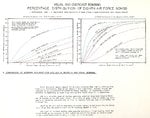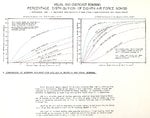The British used individual bombing photographs, along with other data from each aircraft, to build up the overall pattern of the bomb fall relative to the aiming point for the entire raid.
The Americans, bombing in daylight, could take fewer photographs or even film to show the bomb fall of each Group, easily extrapolated to generate an analysis of the entire raid.
Both air forces were trying to establish the same things, most importantly the concentration of the bombing and the accuracy of the bombing.
A good result depended on both these factors. There was no point in achieving a good concentration several miles from the target (inaccurate). Nor was there much good in spreading bombs widely, with the aiming point in the centre of the distribution (poor concentration). Neither stood any chance of destroying the intended target.
Concentration in time was also important, particularly to the RAF which had worked out that for incendiaries to be most effective (the bulk of ordnance carried for a typical area raid) they needed to be dropped in substantial quantities as quickly as possible in order to start a really good fire. Bomber Command became really proficient at this. In the famous Dresden raid 5 Group, which bombed first, dropped 881 tons of assorted ordnance on the city in just 15 minutes (22.13 - 22.28).
Let's put that 881 tons into some kind of perspective. 5 Group dropped 172 x 4,000lb 'cookies', 26 x 2,000lb HC bombs, 72 x 1000lb bombs, 648 x 500lb bombs, 197,178 4lb incendiary bombs and 8,250 4lb incendiary bombs with explosive charges (to discourage fire fighters). This was just the first wave.
No 8 (PFF) Group bombed between 1.21 and 1.45. Its 60 Lancasters included the master bomber, markers and illuminators and backers up. Along with the 10 tons of various markers it dropped 27 x 4,000lb 'cookies', 94 x 1,000lb bombs and 159 x 500lb bombs for a total of 125.7 tons of explosive.
No 1 Group bombed between 1.23 and 1.53 with 248 Lancasters. It dropped 145 x 4,000lb 'cookies', 101 x 2,000lb HC bombs, 111 x 500lb bombs for 397.3 tons of high explosive. It also dropped 312,666 x 4lb incendiaries, a total of 558 tons of incendiaries.
No 3 Group bombed between 1.25 and 1.55 with 151 Lancasters. It dropped 1 x 8000lb 'super cookie', 119 x 4,000lb 'cookies', 84 x 500lb bombs, for a total of 234 tons of high explosives. It also dropped 130,492 x 4lb incendiaries, 233 tons of incendiaries.
No 6 Group bombed between 1.27 and 1.45 with 65 Lancasters. It dropped 65 x 4,000lb 'cookies', 374 x 500lb bombs and 155 x 250lb bombs, 217 tons of high explosives.
The first wave, No 5 Group comprised 240 Lancasters, bombing in 15 minutes. That is better than one aircraft bombing every four seconds.
The second wave comprised about another 550 Lancasters, all bombing between 1.21 and 1.55, just 34 minutes. Again, better than one aircraft bombing every four seconds. Imagine that for half an hour.
Modern commentators don't know what 'shock and awe' really looked like.
Edit: I've just done a quick sum to show that the 2,660 tons of ordnance dropped in two waves of 15 minutes and 35 minutes for a total of just 50 minutes, largely exceeds the roughly 2,000 tons per day average dropped and delivered (by missile) across all of Iraq during the 43 days of the Gulf War.
Steve
The Americans, bombing in daylight, could take fewer photographs or even film to show the bomb fall of each Group, easily extrapolated to generate an analysis of the entire raid.
Both air forces were trying to establish the same things, most importantly the concentration of the bombing and the accuracy of the bombing.
A good result depended on both these factors. There was no point in achieving a good concentration several miles from the target (inaccurate). Nor was there much good in spreading bombs widely, with the aiming point in the centre of the distribution (poor concentration). Neither stood any chance of destroying the intended target.
Concentration in time was also important, particularly to the RAF which had worked out that for incendiaries to be most effective (the bulk of ordnance carried for a typical area raid) they needed to be dropped in substantial quantities as quickly as possible in order to start a really good fire. Bomber Command became really proficient at this. In the famous Dresden raid 5 Group, which bombed first, dropped 881 tons of assorted ordnance on the city in just 15 minutes (22.13 - 22.28).
Let's put that 881 tons into some kind of perspective. 5 Group dropped 172 x 4,000lb 'cookies', 26 x 2,000lb HC bombs, 72 x 1000lb bombs, 648 x 500lb bombs, 197,178 4lb incendiary bombs and 8,250 4lb incendiary bombs with explosive charges (to discourage fire fighters). This was just the first wave.
No 8 (PFF) Group bombed between 1.21 and 1.45. Its 60 Lancasters included the master bomber, markers and illuminators and backers up. Along with the 10 tons of various markers it dropped 27 x 4,000lb 'cookies', 94 x 1,000lb bombs and 159 x 500lb bombs for a total of 125.7 tons of explosive.
No 1 Group bombed between 1.23 and 1.53 with 248 Lancasters. It dropped 145 x 4,000lb 'cookies', 101 x 2,000lb HC bombs, 111 x 500lb bombs for 397.3 tons of high explosive. It also dropped 312,666 x 4lb incendiaries, a total of 558 tons of incendiaries.
No 3 Group bombed between 1.25 and 1.55 with 151 Lancasters. It dropped 1 x 8000lb 'super cookie', 119 x 4,000lb 'cookies', 84 x 500lb bombs, for a total of 234 tons of high explosives. It also dropped 130,492 x 4lb incendiaries, 233 tons of incendiaries.
No 6 Group bombed between 1.27 and 1.45 with 65 Lancasters. It dropped 65 x 4,000lb 'cookies', 374 x 500lb bombs and 155 x 250lb bombs, 217 tons of high explosives.
The first wave, No 5 Group comprised 240 Lancasters, bombing in 15 minutes. That is better than one aircraft bombing every four seconds.
The second wave comprised about another 550 Lancasters, all bombing between 1.21 and 1.55, just 34 minutes. Again, better than one aircraft bombing every four seconds. Imagine that for half an hour.
Modern commentators don't know what 'shock and awe' really looked like.
Edit: I've just done a quick sum to show that the 2,660 tons of ordnance dropped in two waves of 15 minutes and 35 minutes for a total of just 50 minutes, largely exceeds the roughly 2,000 tons per day average dropped and delivered (by missile) across all of Iraq during the 43 days of the Gulf War.
Steve
Last edited:


